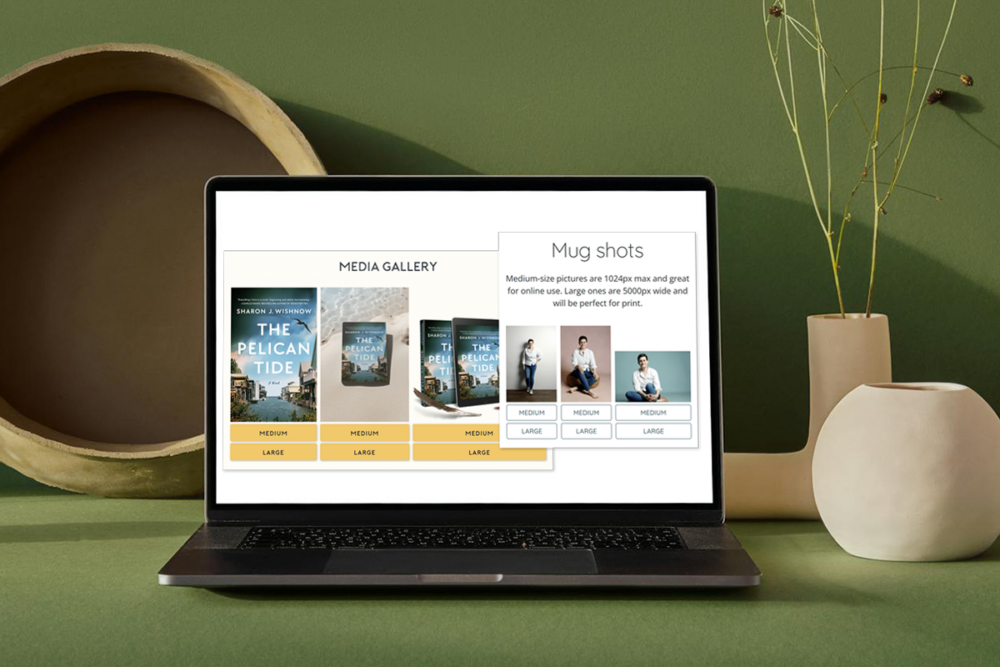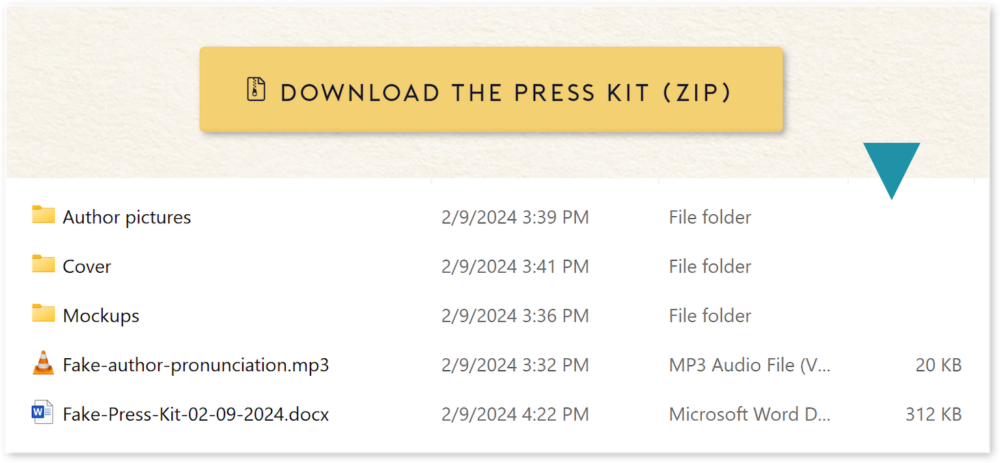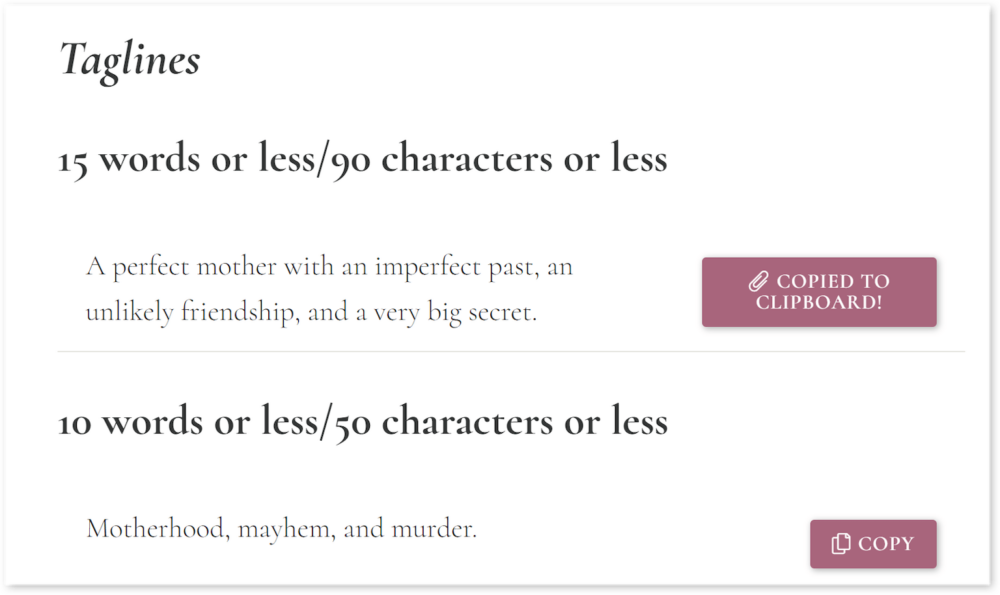
Today’s post is by author and website designer Camilla Monk.
How’s your press kit doing these days? Mine was virtually non-existent until I attended an excellent presentation on author press kits hosted by agent Sarah Fisk for the Authors Guild. Sarah’s insightful and actionable advice led me to reflect on what sort of press kits I—and by extension the bloggers and journalists looking to write about authors and their books—see online: mostly downloadable PDFs with low quality images and limited content.
In other words, the very medium we rely on to advertise our books is, more often than not, useless. Journalists and bloggers will find it easier to harvest whatever they can from your website than download your press kit—unless you turn it into an invaluable tool box for the hurried journalist. Here’s how:
1. No PDF
In the name of all faceless interns trying to glue together an online news article at the last minute, please don’t use a PDF.
- Copying text from a beautifully designed PDF file can quickly turn into a headache if the pasted contents end up looking like a mangled soup of words.
- Images in PDF files are compressed and difficult to extract. Should they screen capture, crop, and export? Convert the PDF into a docx file, then export the images? All terrible solutions that will make bloggers and journalists secretly hate you a little as they struggle to snatch a low-quality pic of you.
So, if you’re not doing an online press kit as I recommend in point 2, go for a simple Word document and make everyone’s life marginally easier. You want people to distribute your materials widely: make it easy for them.
2. Have an HTML-based press kit at your website
A well-constructed HTML page at your website is quite simply the easiest way to share both text and images at various resolutions with your visitors. Set up a page where you’ll gather all the information and offer downloads of any relevant materials (sample, photos, and maybe a docx version of your kit’s content for users who simply can’t work any other way.)
Alternatively, or additionally, you can offer a zipped download of your complete kit, with the text content as a Word file, and subfolders where your media content will be organized and clearly labelled, for example: Media/Author pictures/Jane-Doe-High-Res.jpg
Steer clear of advanced design on your press kit page: you want text that’s easy to copy and doesn’t come laden with unnecessary colors and fonts.

3. Make your kit exhaustive but not exhausting
Here, I’ll direct you to Sarah’s most excellent and fairly exhaustive Press Kit Checklist. Read it attentively: you might find items you’d never thought of adding, or never even heard about. More than just a checklist, it’s a great introduction to building your marketing platform at large.
Book club questions, games, fun facts, Q&A? Not everything in this list is relevant to you or your title. Try to pick wisely and not overcrowd your press kit with material that might provide very little value to the media.
The first criteria for any piece of your press kit should be: How does this meaningfully relate to my book? And the second is: How does this contribute to building my professional image?
Note the nuance in the latter: The point is not just to talk about yourself, but rather to construct an image of yourself as an author. Say that you’re writing women’s fiction: anecdotes about your family life and career struggles are relevant not only to your books, but also to the image you want to project to your readers, someone women and parents can relate to. If, however, you’re writing a spy thriller or epic fantasy, this information becomes a lot less valuable and may unnecessarily crowd your kit.
4. Build a solid media gallery
You want that book cover and your author headshots to circulate, so help bloggers and journalists do their job!
Include a full gallery of author pictures, cover images, and book mockups. These can be real shots of your books taken by a photographer, or images you generate with online software like Canva, Placeit, or Smartmockups. (This list is not exhaustive.) For each image, make sure you’re offering both medium and high resolution: online journalists may want a lighter image that they can quickly upload, whereas YouTubers or print media will prefer high resolution materials.

Consider a mood board as well: a collection of high-resolution, royalty-free images that paint the atmosphere of your book. Reviewers will love to tap into those to illustrate their social media posts or videos.
As I mentioned earlier, make sure to clearly label each image and describe what it is, and its resolution (low, medium, or high.)
5. Don’t forget samples and ARC links
Whether you’re traditionally or self-published, you probably have samples of your book (and audiobook, if applicable.) Don’t forget to include those, along with links to Advance Reader Copy platforms like Netgalley, if applicable, to encourage any visitor to read and possibly review your book. Again, the name of the game is to make it easy for anyone to click and find more.
6. Lastly, stand out with copy buttons!
It’s such a simple and silly trick and I can’t believe it took me listening to Sarah to think of this. Your press kit targets media who might write about your title on a variety of media platforms: articles, reviews, YouTube videos, etc. They need to work fast and efficiently, and part of their job entails painstakingly copying material from your kit.
So why not make their job ten times easier by dividing your content into sections, each coming with a “copy” button? Want a brief description or tagline to open your review? BAM. It’s done.
This doesn’t require advanced tech capabilities. Here’s an example of what it looks like:

TL;DR: Make it easy for everyone to propagate your press material
This list is not exhaustive, and you might come up with great ideas of your own on how to make it simpler for reviewers and the media to find and use the material they need. Ultimately, that’s all there is to the art of making a press kit—put yourself in the intended user’s shoes and ask yourself:
- Is this relevant?
- Is this easy to find?
- And is it easy to use and distribute?
Camilla Monk spent over a decade in advertising, building rickety websites for financial companies before she turned her wiles to writing. She has since traditionally and self-published a six-book romantic suspense series, Spotless, as well a three fantasy titles. These days she shares her time between writing more high-octane nonsense and designing websites for book industry professionals.

For an actual example of a press kit following those rules, you can take a look at Sharon Wishnow’s website: sharonwishnow.com/press-kit 🙂
Thanks so much for the example!
So perfect! I did a pretty poor Covid Time job online promoting my first novel. I swore I would do better for the next book which is coming soon. Gonna get on these recommendations ASAP. Thank you!
So much to consider! But I appreciate your giving us such practical advice. I’m just getting started, so this info gives me details on how to move ahead.
Clear, useful, practical info. Headed off to upgrade my press materials right now….
Thank you for this. Some of these steps described as simple I found tricky. For example adding a Copy button. I have a Wix website. So far, unless I am missing something, requires writing html code. How does one instruct a download button to access press files? Sorry, I’m stuck.
This does require some HTML footwork, but a quick Google search turned this up. Wonder if it would work for you?
https://www.wix.com/app-market/clip-copy-to-clipboard-button
Oh, how much time this would have saved me over the years if everyone followed this advice! Especially love the suggestion of offering a selection of images in different resolutions/file sizes. Back when I worked for print publications, I can’t tell you how many times I received a press release with a photo embedded in it. That meant I’d have to followup to request the photo as a JPG, and inevitably, I’d hear, “Can’t you just pull the photo out of the press release?” No, not when I need a high-res image. It was like PR people assumed we’d just run the whole press release, as is. No, we need the individual parts (text, photo, etc.) to assemble it for our format.
Wow. Awesome information. Thank you!
This is so helpful – thank you! I’m wondering, though, if the link to your media kit should be found on the website or sent as a link (a “hidden URL”) to those media professionals you’re working with. I.e., should I set up a page on my website labeled “Media” which includes links to interviews and podcasts I’ve been on plus a form for people to fill out to receive a link to my downloadable media kit? Is there any benefit to having this level of “security”? Thanks.
In case Camilla doesn’t jump in here: I’m not sure why you’d need/want security around publicity materials, since the point is to distribute the exact information you want made available to public. It should also save you the time of fielding requests and/or distributing them if everything is easily found on your website.
If you were distributing a review copy, security is understandable, but those aren’t typically part of a media kit and are sent through other methods (e.g., NetGalley, BookFunnel, private link that expires).
Exactly, I personally wouldn’t hide the contents of a press kit, even high-res images, but if you want to, and you’re using WordPress, there’s an option to set a post as password protected. Be aware that this option may not work as intended if you also use a plugin to conceal your wp-admin folder’s url.
People will then have to contact you so you can share the password. Unless you’re Stephen King or Sarah J. Maas, however, I wouldn’t be picky about sharing a press kit. 😉
Thank you! Just a noob request. I get a fair amount of spam messages through my website and on Facebook on my author page – and also recently one of my books was put up on an audiobook website with an AI reader – so I didn’t know what should be kept un-liftable.
Can you tell me which audiobook website it was?
It was soundcloud.com. Luckily, the website has an option to report the copy as not a legitimate copy created by the author(s). We got it deleted!
For spam, I use Clean Talk and I’ve been fairly satisified with it! To avoid piracy, yes, it’s best to not give away distribution files directly through your website.
Having said this, I personally have a laid-back policy regarding piracy as I choose to consider that a free reader is still a reader and they might rate or review. Also, a majority of your freeloaders might have never been become readers anyway, either because they don’t have the budget, or more frequently, because they live in countries where your books aren’t distributed, or aren’t affordable based on local living standards.
I’m a journalist who has been driven mad by PDF-ridden press kits.I want to say Thank you Camilla! I hope everyone heeds her wise advice, just do it in word or pages or anything but a PDF!
You’re welcome!